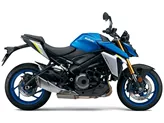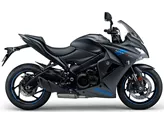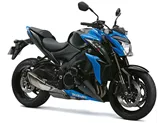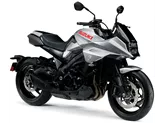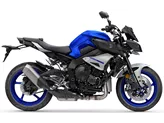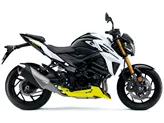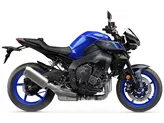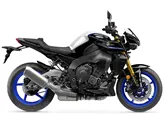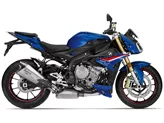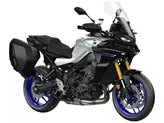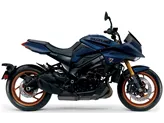Suzuki GSX-S1000 2018 vs. Yamaha MT-10 2016

Suzuki GSX-S1000 2018

Yamaha MT-10 2016
Vue d’ensemble - Suzuki GSX-S1000 2018 vs Yamaha MT-10 2016
When comparing the Suzuki GSX-S1000 2018 and the Yamaha MT-10 2016, it is clear that both bikes have their own unique strengths and weaknesses.
Starting with the Suzuki GSX-S1000 2018, it boasts a stable handling that inspires confidence, making it a great choice for riders who value control and precision. Its engine power of 149 HP and torque of 106 Nm provide a wonderfully sporty experience, delivering strong acceleration and exhilarating performance. The bike's injection fuel system ensures efficient fuel delivery, while its liquid cooling system helps maintain optimal engine temperature. With a displacement of 999 ccm, the GSX-S1000 offers a good balance between power and efficiency.
In terms of suspension, the GSX-S1000 features an upside-down telescopic fork at the front and a swing arm with a monoshock at the rear, providing a comfortable and smooth ride. The aluminium frame, specifically the twin tube design, offers a lightweight yet sturdy construction, contributing to the bike's overall stability and handling. The double disk brakes with a diameter of 310 mm provide reliable stopping power, and the advanced rider assistance system of ABS ensures added safety during braking maneuvers.

Suzuki GSX-S1000 2018
In terms of dimensions and weights, the GSX-S1000 has a front tire width of 120 mm and a rear tire width of 190 mm, both with a diameter of 17 inches. The wheelbase measures 1460 mm, providing stability and maneuverability. The seat height of 815 mm offers a comfortable riding position for most riders, and the bike has a kerb weight of 209 kg, including ABS. The fuel tank capacity of 17 liters allows for longer rides without frequent refueling.
On the other hand, the Yamaha MT-10 2016 offers some unique strengths of its own. Its engine power of 160 HP and torque of 111 Nm provide a strong character and exhilarating performance. The bike's injection fuel system ensures efficient fuel delivery, while its liquid cooling system helps maintain optimal engine temperature. With a displacement of 998 ccm, the MT-10 delivers impressive power and acceleration.
Similar to the GSX-S1000, the MT-10 features an upside-down telescopic fork at the front and a swing arm with a monoshock at the rear, providing a comfortable and smooth ride. The aluminium frame, specifically the Deltabox design, offers a lightweight yet sturdy construction, contributing to the bike's overall agility and high-speed stability. The double disk brakes with a diameter of 320 mm provide strong and reliable stopping power. In addition to ABS, the MT-10 also features traction control, further enhancing its safety and stability.

Yamaha MT-10 2016
In terms of dimensions and weights, the MT-10 has similar specifications to the GSX-S1000, with a front tire width of 120 mm and a rear tire width of 190 mm, both with a diameter of 17 inches. The wheelbase measures 1400 mm, slightly shorter than the GSX-S1000, but still providing good stability and maneuverability. The seat height of 825 mm may be a bit higher for some riders, and the bike has a kerb weight of 210 kg, including ABS. The fuel tank capacity of 17 liters is the same as the GSX-S1000, allowing for longer rides without frequent refueling.
In terms of weaknesses, the Suzuki GSX-S1000 2018 is reported to be a little jerky when changing from push to load. Some riders also feel that a quickshifter with blipper would greatly enhance the bike's performance. On the other hand, the Yamaha MT-10 2016 is criticized for its poor comfort, limited wind protection, and hard fit.
In conclusion, both the Suzuki GSX-S1000 2018 and the Yamaha MT-10 2016 offer unique strengths and weaknesses. The GSX-S1000 excels in stable handling, sporty engine performance, and overall riding comfort. The MT-10, on the other hand, impresses with its strong character, agility, high-speed stability, and advanced rider assistance systems. Riders should consider their priorities and preferences when choosing between these two naked bikes.
Caractéristiques techniques Suzuki GSX-S1000 2018 par rapport à Yamaha MT-10 2016
Avantages et inconvénients en comparaison
Avantages et inconvénients en comparaison
Suzuki GSX-S1000 2018

La GSX-S 1000 de Suzuki a un look sexy, un son puissant et un matériel vraiment élégant. Elle est stable, facile à conduire et agréable à conduire. Si nécessaire, le moteur met les gaz. Mais il peut aussi être conduit avec douceur. Comparée aux Powernakeds les plus raffinés, il lui manque quelques caractéristiques, mais si l'on regarde l'étiquette de prix, on s'en rend compte rapidement : Un excellent choix !
Yamaha MT-10 2016

La MT-10, courte et trapue, est la plus éloignée de la superbike R1, tant au niveau de l'esthétique que du châssis, mais le cœur de la MT-10 est directement issu de l'arme de la piste de course et fascine par sa sonorité brute unique et sa force d'attaque par le bas grâce au décalage typique des tourillons qui, avec une séquence d'allumage modifiée, lui confère ce caractère unique. Les 160 ch qui en résultent ne semblent donc que sur le papier un peu faibles par rapport aux plus de 200 ch de la R1, mais en réalité, la MT-10 déclenche elle aussi un feu d'artifice incroyable. Le châssis serait probablement trop souple pour la piste de course, mais il est tout à fait adapté à un combat sur route et le freinage fait de même - acceptable pour la piste, mais parfait pour la route.
Comparaison des prix Prix moyen du marché Suzuki GSX-S1000 vs Yamaha MT-10
There are a few key differences between a Suzuki GSX-S1000 2018 and a Yamaha MT-10 2016. In terms of price, the actual average price of a Yamaha MT-10 2016 is about 6% higher. A Suzuki GSX-S1000 2018 experiences a loss of 270 USD in one year and 1,010 USD in two years of ownership. This is offset by a loss of 800 USD and 1,840 USD for a Yamaha MT-10 2016. Compared to Yamaha MT-10 2016 there are more Suzuki GSX-S1000 2018 bikes available on the 1000PS.de Marketplace, specifically 9 compared to 7. It takes less time to sell a Yamaha MT-10 with 97 days compared to 177 days for the Suzuki GSX-S1000. Since model year 2015 1000PS.de editors have written 36 reviews for the Suzuki GSX-S1000 and 32 reviews for the Yamaha MT-10 since model year 2016. The first review for the Suzuki GSX-S1000 was published on 9/27/2014 and now has more than 17,100 views. This compares to more than 20,700 views for the first review on Yamaha MT-10 published on 11/17/2015.








